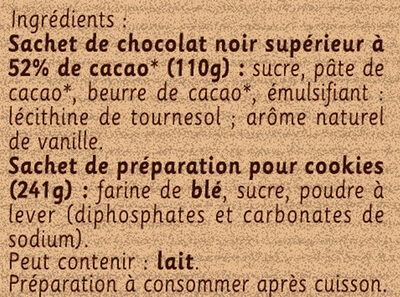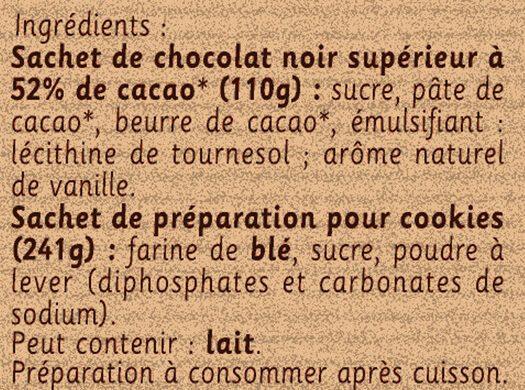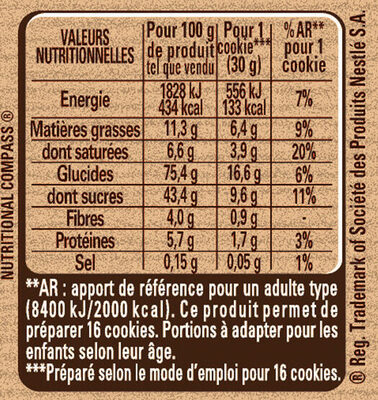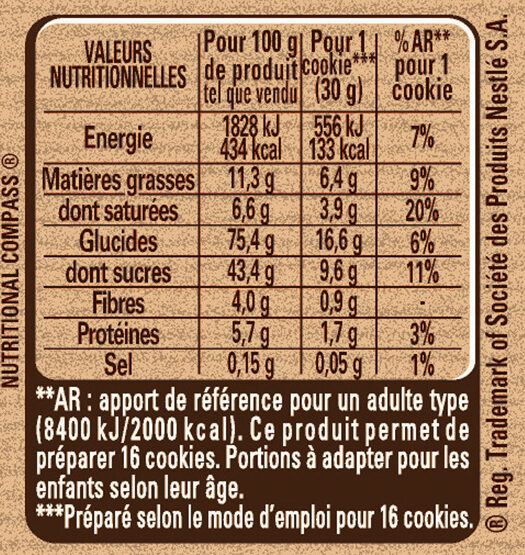NESTLE DESSERT Préparation pour Cookies au Chocolat 351g - 351 g
This product page is not complete. You can help to complete it by editing it and adding more data from the photos we have, or by taking more photos using the app for Android or iPhone/iPad. Thank you!
×
Some of the data for this product has been provided directly by the manufacturer NESTLE FRANCE. - Customer service: Contact form 0 809 400 412 (service gratuit + prix de l'appel)
Barcode: 7613034065933 (EAN / EAN-13)
Common name: Préparation pour cookies aux pépites de chocolat
Quantity: 351 g
Packaging: Box, Pack, Sleeve, fr:Boîte en carton, fr:Sachet en plastique
Brands: Nestlé, Nestle dessert, Préparations
Categories: Snacks, Desserts, Sweet snacks, Biscuits and cakes, Biscuits, Cakes, Cooking helpers, Chocolate biscuits, Dessert mixes, Pastry helpers, Baking Mixes, Cake mixes
Labels, certifications, awards:
No artificial flavors, No preservatives, Green Dot, No colorings, Nutriscore, Nutriscore Grade E, Rainforest Alliance, Triman


Stores: Magasins U, carrefour.fr
Matching with your preferences
Other information
Preparation: Pour 16 cookies. Ajoutez 70 g de beurre et 1 œuf. Préchauffez votre four 10 minutes à th 6/7 (200°C). Versez le contenu du sachet de préparation dans un saladier, ajoutez-y un œuf et 70 g de beurre mou. Mélangez bien pour obtenir une pâte homogène puis ajoutez les mini-palets. Pétrissez la pâte jusqu'à l'obtention d'une boule. Formez 16 boules et disposez-les sur une feuille de papier sulfurisé posée sur la plaque du four. Aplatissez légèrement à la main. Faites cuire environ 12 minutes au four traditionnel et 8 à 9 minutes au four à chaleur tournante. Laissez tiédir 5 minutes. Pour une cuisson réussie, surveillez vos cookies 2 à 3 minutes avant la fin du temps indiqué.
Conservation conditions: A conserver au frais et au sec.
Customer service: Nestlé France, 34-40 rue Guynemer 92130 Issy-les-Moulineaux
Report a problem
Data sources
The manufacturer NESTLE FRANCE uses Equadis to automatically transmit data and photos for its products.
Product added on by date-limite-app
Last edit of product page on by org-nestle-france.
Product page also edited by charlesnepote, driveoff, ecoscore-impact-estimator, julie-yuka, lecfafa, magasins-u, openfoodfacts-contributors, packbot, quentinbrd, raph2021, roboto-app, tacite-mass-editor, teolemon, yuka.WFpCZlNwOWUrTlFwcS9ZNDdFall5dHQ3d1oyaVVrK3Fjc00vSVE9PQ.














